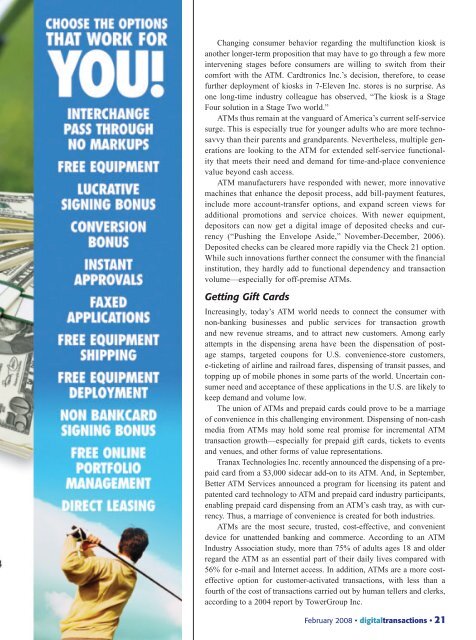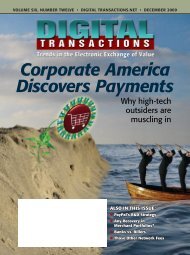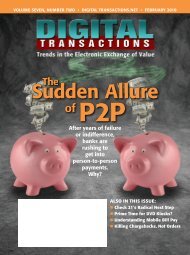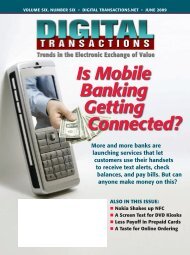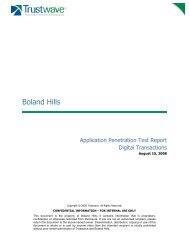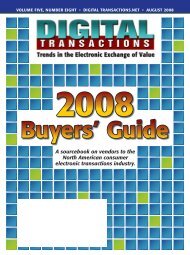The Broken Link - Digital Transactions
The Broken Link - Digital Transactions
The Broken Link - Digital Transactions
Create successful ePaper yourself
Turn your PDF publications into a flip-book with our unique Google optimized e-Paper software.
Changing consumer behavior regarding the multifunction kiosk is<br />
another longer-term proposition that may have to go through a few more<br />
intervening stages before consumers are willing to switch from their<br />
comfort with the ATM. Cardtronics Inc.’s decision, therefore, to cease<br />
further deployment of kiosks in 7-Eleven Inc. stores is no surprise. As<br />
one long-time industry colleague has observed, “<strong>The</strong> kiosk is a Stage<br />
Four solution in a Stage Two world.”<br />
ATMs thus remain at the vanguard of America’s current self-service<br />
surge. This is especially true for younger adults who are more technosavvy<br />
than their parents and grandparents. Nevertheless, multiple generations<br />
are looking to the ATM for extended self-service functionality<br />
that meets their need and demand for time-and-place convenience<br />
value beyond cash access.<br />
ATM manufacturers have responded with newer, more innovative<br />
machines that enhance the deposit process, add bill-payment features,<br />
include more account-transfer options, and expand screen views for<br />
additional promotions and service choices. With newer equipment,<br />
depositors can now get a digital image of deposited checks and currency<br />
(“Pushing the Envelope Aside,” November-December, 2006).<br />
Deposited checks can be cleared more rapidly via the Check 21 option.<br />
While such innovations further connect the consumer with the financial<br />
institution, they hardly add to functional dependency and transaction<br />
volume—especially for off-premise ATMs.<br />
Getting Gift Cards<br />
Increasingly, today’s ATM world needs to connect the consumer with<br />
non-banking businesses and public services for transaction growth<br />
and new revenue streams, and to attract new customers. Among early<br />
attempts in the dispensing arena have been the dispensation of postage<br />
stamps, targeted coupons for U.S. convenience-store customers,<br />
e-ticketing of airline and railroad fares, dispensing of transit passes, and<br />
topping up of mobile phones in some parts of the world. Uncertain consumer<br />
need and acceptance of these applications in the U.S. are likely to<br />
keep demand and volume low.<br />
<strong>The</strong> union of ATMs and prepaid cards could prove to be a marriage<br />
of convenience in this challenging environment. Dispensing of non-cash<br />
media from ATMs may hold some real promise for incremental ATM<br />
transaction growth—especially for prepaid gift cards, tickets to events<br />
and venues, and other forms of value representations.<br />
Tranax Technologies Inc. recently announced the dispensing of a prepaid<br />
card from a $3,000 sidecar add-on to its ATM. And, in September,<br />
Better ATM Services announced a program for licensing its patent and<br />
patented card technology to ATM and prepaid card industry participants,<br />
enabling prepaid card dispensing from an ATM’s cash tray, as with currency.<br />
Thus, a marriage of convenience is created for both industries.<br />
ATMs are the most secure, trusted, cost-effective, and convenient<br />
device for unattended banking and commerce. According to an ATM<br />
Industry Association study, more than 75% of adults ages 18 and older<br />
regard the ATM as an essential part of their daily lives compared with<br />
56% for e-mail and Internet access. In addition, ATMs are a more costeffective<br />
option for customer-activated transactions, with less than a<br />
fourth of the cost of transactions carried out by human tellers and clerks,<br />
according to a 2004 report by TowerGroup Inc.<br />
February 2008 • digitaltransactions • 21


